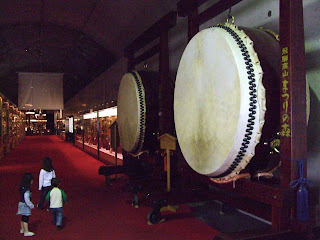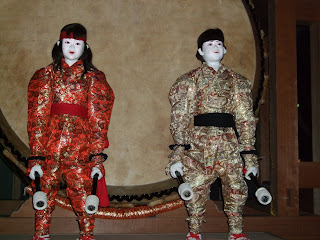In several older posts (here too), I mentioned being encouraged to join a newly forming taiko group, sponsored by Asano Taiko. I was to be a group made up of young, energetic people, with taiko experience, who have a serious desire to learn taiko. Both my wife and I were able to get on the roster for this group and finally, yesterday, we were able to have our first practice. After our first practice, I am very excited about this group. Yet I am disappointed, because as a result of various other events and holidays, we are not scheduled to practice again until May 17.
The group will be taught by Yamada Mizue san of Hono Taiko (also instructing the other groups we're in) and there are nine of us in the group right now. I believe they do not want more than 20, but I think 9 or 10 is a good number anyhow. We are all "young", although some of us would probably be considered as borderline. There are three teenage girls, three members in their 20s and three members in their 30s. It is actually a nice balance, I think.
Although I enjoy the other groups I play in, the members of them come from a wide range of backgrounds and have different goals for playing taiko. Everyone works hard, but you can't challenge people in the same way you can challenge a small, focused group of people, who have their sights set on a high level of performance.
We started practice with some activities I have often wanted to do in my other groups. One of those is metronome practice, the other is working on basic rhythms. For example, two measures of quarter notes, two measures of eighth notes, two measures of sixteenth notes and two measures of don doko don doko rhythm, and then following that same pattern in reverse. First we did it starting with our right hand, and then starting with our left hand. I think we must have done this type of practice for about 30 minutes. Since I have a professional drummer as a brother, I am aware that this type of practice is extremely important, and have wished it were more often a part of practices. I'm looking forward to developing my internal metronome and increasing my left arm/left hand strength.
Following this we looked at the beginning of the song we will learn. Apparently, our debut will be at the Asano recital in the fall, September or October, I believe. She gave us the music for the first half yesterday. The rhythms are harder than what I've been learning so far, but I didn't see any extremely difficult rhythms. Yamada san said the challenging aspect of the piece is that it is quite fast and physically demanding. It has three parts, Odaiko, Nagado and Shime taiko. There will be two Odaiko players (I am tentatively one of them), two Shime taiko players, who have not yet been chosen, and the remaining five will play Nagado taiko.
I am looking forward to practicing with this group of people, who all want to be challenged and improve their taiko playing.
2008-04-19
Jigen - New Taiko Group
2008-04-09
World's Largest Drums
This past weekend, we were able complete another taiko pilgrimage. We all got in the car and drove about two and a half hours to nearby Takayama City in nearby Gifu prefecture. Takayama looks like a nice town, with the Japan Alps as a backdrop. We did not have time to explore the town much. Our destination was the Matsuri no Mori museum (The Festival Forest Museum). The museum was built by a man who loved Japanese festivals and had a special passion for taiko drums. This passion led him to commission Asano Taiko to create the world's largest taiko drums, to be housed at this museum. This museum is built into the side of a mountain. When you enter a long hallway, lined with miniature festival carts on one side, and elaborate screens depicting various festivals on the other, leads you to the main hall, which houses about 10 or 15 huge carts and of course, the taiko.
At the entryway, when you first enter the museum, there are two Ohirado taiko. They are the same diameter as the Odaiko in the main hall, but much flatter. You are allowed to play these drums if you like. I hit them with my fist a couple times and the sound echoed through the large hallway like rolling thunder. I thought how much more powerful it would sound if I actually had a pair of sticks to use. (I found out after returning home and talking with some friends, that museum guests are welcome to bring taiko sticks and play these hirado taiko with the sticks. This seems too good to be true, but if they say so...)
My son really enjoyed playing these drums and we finally had to drag him away, kicking and screaming, to see the rest of the museum.
In the main hall, you can see the three Odaiko on a stage. These are the largest taiko in the world.
Here are the statistics on them.
#1 (on the right)
Diameter - 2.73 meters
Length - 2.73 meters
Weight - 4.5 metric tons
#2 (on the left)
Diameter - 2.67 meters
Length - 2.73 meters
Weight - 4 metric tons
#3 (on the top)
Diameter - 2.4 meters
Length - 2.48 meters
Weight - 2 metric tons
From felling the tree, to the completion of these drums, it took about 3 and a half years. The tree was a Karak tree (?) from Cameroon, Africa. At the trees widest spot, it had a diameter of 3 meters, and the tree itself was 1300 years old.
That is the one tragic thing about these drums. I don't know the whole situation surrounding this tree, why they cut it down, but it seems sad that such an old tree would be cut down.
Of course these drums are made by Asano, so I asked some friends who work at Asano how much it cost to make these drums. Apparently, they were around 500,000 USD each! So that means on that stage there is approximately 1.5 million dollars worth of drums.
Each exhibit in this museum also has what the Japanese call karakuri ningyo, which are moving dolls/mannequins. I think the English info there called them marionettes, except, these do not have strings attached to them. At any rate, the taiko also have some moving statues that play them so visitors can hear what the drums sound like. They started playing when I was still in the entry hallway and it did really sound like thunder. There are a couple of unfortunate aspects about this situation, though. First of all, the sticks are padded mallets, so you really don't get a nice big sound like you would with proper wooden sticks. (at least you get to hear it though). Secondly, the arms of the mannequins are so long that they look like orangutan children. It is not so obvious when their backs are to you as they play the drum, but it is quite surprising when they turn around at the end and bow.
Finally, I have a short video I took with my digicam of the mannequins playing the drums. It is not the same as being there, but please enjoy it all the same.
Here is a video of the mannequins playing the drums:
2008-04-02
Back from Spring Break
We just returned from about 8 days of traveling around Shimane and Hiroshima prefectures, in south-western Honshu. It was our family spring break trip and our first major road trip in Japan. (Read about my japanese road trip experiences here.) Everyone asks us why we decided to go to Shimane prefecture. Apparently it is not a very popular tourist destination. It is very "countryside", so a bit inconvenient to travel to, but still, a beautiful part of Japan. To answer the why question, it is because my mother had been there once before and wanted to visit again. It turns out, however, that there was a slight taiko connection in traveling there. We learned soon after deciding to spend our spring break there, that Yamada san of Hono Taiko, who also instructs our Yume Mitai and Matto Bayashi classes, is from Shimane prefecture. So we got to visit the home prefecture of our main taiko instructor.
The down side of the trip was that I had to miss taiko practices on Monday and Tuesday last week. You would think one week is not that big of a deal, but I seriously notice a difference when I cannot practice, even for a week. Not only do I miss playing, but I can feel my body losing strength. We did make it back in time for this week's practices, however, and after only 15 minutes or so of practice on Monday night, I could feel everything coming back to me. I felt re-energized, refreshed.
Another positive thing happened at Monday's practice. I believe I mentioned a new Asano sponsored group being formed called Jigen in a previous blog. I had expressed disappointment at being too old to join the group, which had set the age limit from 14 - 30 years old. At Monday's practice, though, Yamada san again inquired of my age. Upon telling her that I am 33 she said, "oh, well then you are okay to join Jigen" (the new group). I said, "What, they raised the age limit?" and she said, "Yeah, many of the people that wanted to join were already in their thirties, so they decided to take people up to 35." I can't tell you how excited I am about this. This should be a fairly high level group, that will offer a real challenge and the focused training we are seeking. I do take it as a compliment that I have been encouraged to join, but I learned that part of the reason is also because of my gender. There are currently about 8 people lined up, two of which are male, so they are doing their best to try to balance it out between men and women a bit more. The first practice will be April 19. My wife will join as well, for the time being.





